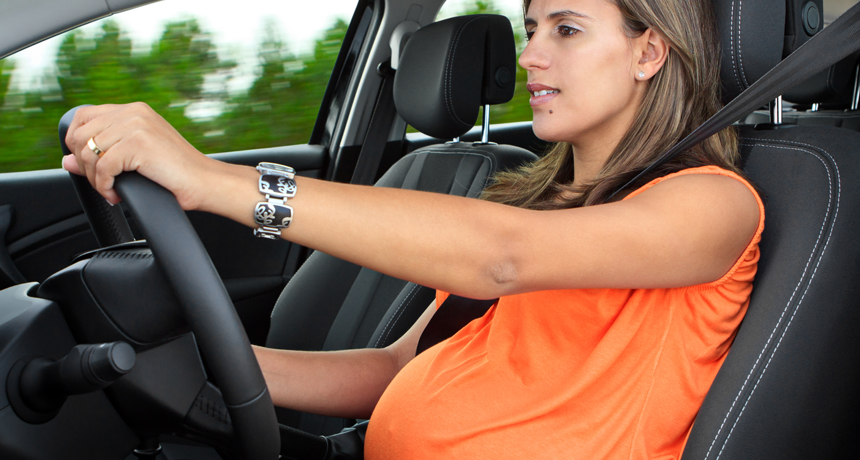Study on pregnant women’s driving has some potholes

During the second trimester of pregnancy, women got into more car crashes than before they were pregnant, a new study finds. But that spike could be due to more road time.
Fernando Madeira/Shutterstock
- More than 2 years ago
For some women, pregnancy comes with all sorts of travails: Nausea, headaches, back pain, cankles. Now, a study suggests a previously underappreciated one. Pregnancy makes women more likely to get into a serious car crash, scientists reported May 12 in the Canadian Medical Association Journal. Although the numbers show a clear uptick in accidents during the second trimester of pregnancy, I’m not convinced that pregnancy, or its symptoms, is to blame.
Women drivers were 42 percent more likely to show up in the ER for treatment for a car crash while in their second trimester of pregnancy than before they were pregnant, a review of over half a million pregnant Ontario residents found. Pre-pregnancy, these women got into an average of 4.55 crashes per 1,000 people per year. (That’s about double the population average, probably because these women are younger than the average driver.) During the second trimester, that number climbed to 6.47 accidents per 1,000 people per year, researchers found. No such increases were found for the first or third trimesters.
Small, momentary lapses of attention, perhaps exacerbated by pregnancy symptoms such as fatigue, stress and insomnia, may explain the crash spike, says study coauthor Donald Redelmeier of the University of Toronto. “About 50 percent of pregnant women describe episodes of absentmindedness during pregnancy,” Redelmeier says, and those brief lapses can be disastrous when driving.
But could a simpler explanation be driving the increase? I think so, and not just because I feel like pregnant women need a little bit of love. The study didn’t look at how often women were driving. That means that the results could be explained by the simple fact that women in their second trimester could be driving more than women earlier or later in pregnancy, making them more susceptible to crashes.
Pieces of the data seem to support this explanation: Post-baby crash rates plummeted. In the first few months with a crying, non-sleeping, demanding newborn, women got in way fewer accidents than before they were pregnant. Were these sleep-deprived moms all of a sudden paragons for safe driving? Doubtful, I say. Much more likely is that these women weren’t driving much. In my first few months with Baby V, we were almost exclusively pedestrians, a habit that drastically lowered my risk of a car crash.
In contrast, women in their second trimester might be driving more than usual. Sometimes called the honeymoon phase of pregnancy, the second trimester often brings an end to the worst of the first trimester nausea and a dose of extra special magic pregnancy energy. Countless doctor’s appointments, baby prepping errands, work projects and gym visits might compel an energetic pregnant woman to jump behind the wheel more than usual.
Another tidbit that supports this alternative explanation is that car accidents did not go up in pregnant women who lived in rural areas, says Rebecca Goldin, mathematician at George Mason University in Fairfax, Va., and director of STATS, a nonprofit statistical watchdog group. Overall, rural women had a higher rate of car crashes than urban women, but those rates didn’t climb with pregnancy. Women who live in the country have to drive — they can’t rely on public transportation to get them to their destination. But pregnant women in the city, who can rely on trains and buses to get around, might opt to take a car instead, increasing their time on the road and their chances of getting in an accident.
Another monkey wrench in the study data: Pregnant women might be more inclined to head to the ER when involved in a crash. “I think it’s quite believable that pregnant women would be more likely to want to be checked out, or have additional concerns about being in an accident, compared with women who aren’t pregnant,” Goldin says. Because the study tallied up only women who went to the ER after a crash, the results might be influenced by pregnant women’s desire to play it safe.
These alternative explanations don’t make the spike in accidents and ER visits disappear. Whether these wrecks are caused by pregnancy symptoms or simply more driving, they are still dangerous, and perhaps avoidable, situations.
Simple road safety habits can go a long way to help minimize the risk of an accident, Redelmeier says. Don’t speed, wear a seatbelt, and obey traffic laws, he says. Those are good reminders for all drivers, not just pregnant ones.
One final thought: In case any overprotective dudes out there insist on taking the keys, consider the fact that men around the same age as the women in the study have an even higher risk of a car crash than pregnant women. So ladies, pregnant or not, keep the keys but, as always, drive carefully.







